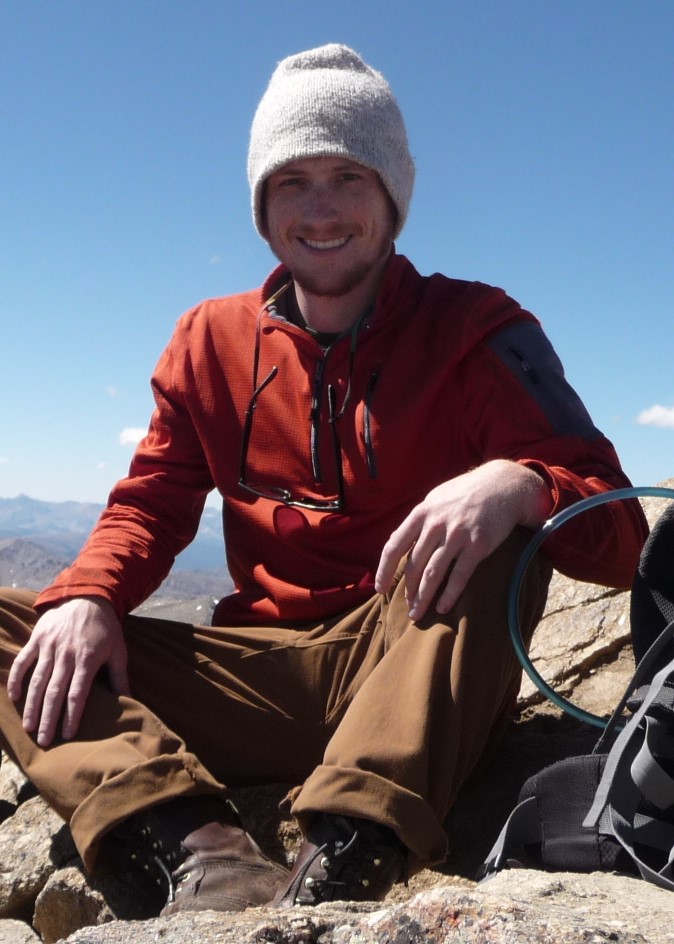
Reflections on grad school
By Aaron Sidder
Author’s note: In August, I completed my Master’s thesis and graduated from the Graduate Degree Program in Ecology after three years in the program and NREL. As part of my thesis, my committee asked me to include a reflective essay on my time as a graduate student. I am publishing this excerpt from my thesis at their behest, in the hope that it might be of some help to current and future graduate students in NREL. This section of my thesis contains my reflections on species distribution modeling, my graduate experience, and suggestions for incoming graduate students.
The full thesis, along with supplementary materials and data sets, can be found at this link: https://dspace.library.colostate.edu/handle/10217/167184.
On Modeling

Graduate school is littered with “Aha!” moments. Sometimes these moments reflect relatively small triumphs—cracking an obstinate chunk of code or finding the elusive words to end a paper—but sometimes they provide a moment of clarity that helps elucidate a key concept or question. For me, an important “Aha!” moment helped me to better understand the “why” of ecological models. One of my favorite courses in the Graduate Degree Program in Ecology (GDPE) is taught by Dr. Tom Hobbs, Models for Ecological Data. Early in the course, Dr. Hobbs came to class with a fly fishing rod, a recording of “Madame Butterfly” by Giacomo Puccini, and a print of “Starry Night” by Vincent van Gogh; somehow these items all related to Bayesian statistics and modeling. These seemingly disparate items all had one characteristic in common: they represented abstractions, or simplifications, of reality. He went on to explain that models of ecological phenomena are also just abstractions of complex and dynamic systems. George E.P. Box (1987) is widely credited with saying, “Essentially, all models are wrong, but some are useful,” and Dr. Hobbs helped me to truly understand what this means.
This lesson in abstraction has helped define my approach to species distribution models (SDMs) and has aided in my interpretation of modeling research. Models can be incredibly useful tools for deriving relationships between a species and its environment and can clarify general trends across time or space. However, there is a tendency among modelers to over-emphasize results, especially when projecting future responses to novel conditions. This has resulted in two broad opinions on the utility of SDMs: those who believe in their usefulness and those who do not. I have experienced this dichotomy in my own research, and I believe that my awareness of it has made me a better modeler and scientist.
There are two particular papers that helped clarify my thoughts on the proper usage of SDMs. The first, Araújo and Peterson (2012), eloquently summarizes the uses and misuses of SDMs. The second, Pearson and Dawson (2003), discusses the limitations of predictive modeling and the importance of spatial scale in the application and interpretation of models. Combined with my own experience, these studies have greatly informed my approach to correlative modeling. First, scale matters! The scale of the variables used and the extent of the study region should be defined by the processes being examined. For example, an assessment of climatic interactions should be defined at regional to continental scales (> 200 km) where large-scale processes are more likely to influence distribution. Variables like land-use and dispersal play a far greater role in shaping a species distribution at smaller scales (Pearson and Dawson 2003). The details of the modeling process (e.g. variables used, grain size, extent) should be scaled based on the processes examined.

Second, it is critical to investigate any biases and assumptions in the modeling process. Sampling bias can misinform models, so it is important to thoroughly understand and vet the data used in the models. There are many ways to address sampling bias in the modeling process (Anderson and Gonzalez 2011, Barbet-Massin et al 2012, Boria et al. 2014), and these should be implemented to produce the best possible models. Some examples of how to do this include spatial filtering of the occurrence data and restricting the selection of background pseudo-absences to general areas of use for the species. Other assumptions and uncertainties, like species-environment equilibrium (Wiens et al. 2009), are more difficult to address but should be accounted for in the discussion and interpretation of the results. Uncertainty is inherent in most data sources, in particular models of future climatic conditions, and this should be explicitly discussed.
Uncertainty is largely unavoidable in ecological modeling. Some approaches, like Bayesian models, quantify uncertainty, but this is less frequent with correlative models. This uncertainty does not invalidate models, but it should guide the interpretation and application of correlative models. Outputs from these models should be treated as distributional hypotheses (Lobo et al. 2008), and particularly at larger scales, are more useful in defining general trends (e.g. upwards range expansion) than predicting specific locations of occurrence. Though many modelers use SDMs for prediction, I am of the opinion that this is generally an inappropriate usage. When a prediction is a goal, it should be used in conjunction with field sampling and monitoring to validate results. There is danger in wholeheartedly believing in model predictions, but they are nevertheless useful tools for identifying important relationships and possible future trends.
On graduate school
Over the past three years, I have grown particularly interested in how climate change shapes large-scale landscape patterns. With every passing year, the implications of climate change become direr, and ecologists are increasingly asked to assess the effects of this change and the resulting impacts on ecosystems, now and in the future. I believe my research has provided me with the skills and knowledge needed to address the impacts of climate change, and a good foundation on which to continue building my career. Of course, there were many challenges to graduate school, and I would like to spend a little time imparting my own lessons-learned to ease the process for future students. What follows are my thoughts on how to best tackle grad school. It is, by no means, the only path to success, but I hope it is helpful to any readers.
When I entered graduate school, I was primarily interested in quantitative research tools more so than specific ecological systems or questions, so I spent my first year focused on learning these tools and less time familiarizing myself with foundational ecological principles. As a result, the tools guided the development of my research in its early stages instead of compelling ecological questions. I ultimately came to understand that the question should guide the methods, and be working backward from a broad ecological question—e.g. how does climate change drive bark beetle outbreaks?—will open up more research possibilities than trying to fit a tool to a problem. Also, from a practical perspective, taking courses on quantitative methods at a more advanced stage of one’s degree allows for the incorporation of class projects as elements of a thesis or dissertation.
A note to modelers and others whose research does not require much field work: it is easy to get caught up in the reading, writing, and coding of grad school, but it is essential to take the time to just be in the environment you study. Do not forget to spend time in the study system; if that is not possible, at least spend time outside in natural settings. Further, take time to just sit and observe with all your senses. These periods of reflection and observation are essential for grasping how a system functions and will ultimately yield a deeper understanding of any results from modeling or geospatial analyses. Observation is at the root of the scientific method, so take the time to truly observe what is happening in your system.
Lastly, it is vital to find an academic community while in graduate school. In my experience, it is incredibly important to find other scientists working in the same system and addressing related questions or using the same tools. This community will challenge you to improve your research and can be a significant support during the challenging periods that are inherent to graduate school. Having a friend to read a draft or help troubleshoot a technical difficulty can make a big difference in both the quality and enjoyment of one’s work. Conversely, graduate school is a wonderful time to intellectually explore a wide variety of research, so do not restrict yourself only to topics that relate to your research. Reading broadly (and attending lectures) will help provide perspective on your work and that of your colleagues. Occasionally, methods used in other fields may also apply to a problem in ecology.
Completing my thesis was one of the most difficult professional endeavors of my career, but along the way, I developed a diverse skill set that will benefit me throughout my career. Furthermore, I reveled in the intellectual stimulation of graduate school and leave with many close friends and terrific memories.
REFERENCES
Anderson, R. P. and Gonzalez, I. 2011. Species-specific tuning increases robustness to sampling bias in models of species distributions: An implementation with Maxent. – Ecol. Modell. 222: 2796–2811.
Araújo, M. B. and Peterson, A. 2012. Uses and misuses of bioclimatic envelope modeling. – Ecology 93: 1527–1539.
Barbet-Massin, M. et al. 2012. Selecting pseudo-absences for species distribution models: How, where and how many? – Methods Ecol. Evol. 3: 327–338.
Boria, R. A. et al. 2014. Spatial filtering to reduce sampling bias can improve the performance of ecological niche models. – Ecol. Modell. 275: 73–77.
Box, G. E., & Draper, N. R. 1987. Empirical model-building and response surfaces. – John Wiley & Sons.
Pearson, R. G. and Dawson, T. P. 2003. Predicting the impacts of climate change on the distribution of species: are bioclimate envelope models useful? – Glob. Ecol. Biogeogr. 12: 361–371.
Wiens, J. A. et al. 2009. Niches, models, and climate change: assessing the assumptions and uncertainties. – Proc. Natl. Acad. Sci. U. S. A. 106: 19729–19736.
 Aaron Sidder is a former editor of EcoPress and a 2015 graduate of the Graduate Degree Program in Ecology. In October, he begins contracting with the U.S. Geological Survey modeling habitat for endangered bird species.
Aaron Sidder is a former editor of EcoPress and a 2015 graduate of the Graduate Degree Program in Ecology. In October, he begins contracting with the U.S. Geological Survey modeling habitat for endangered bird species.
Featured image by Christine Zenino from Chicago, US (Greenland reflections…) [CC BY 2.0 (http://creativecommons.org/licenses/by/2.0)], via Wikimedia Commons